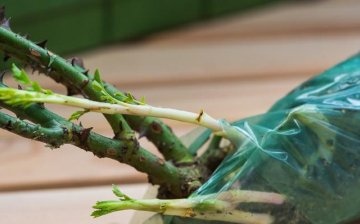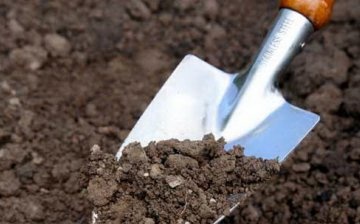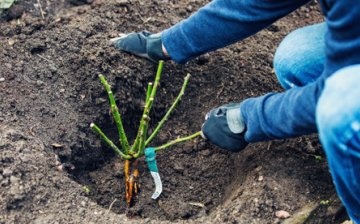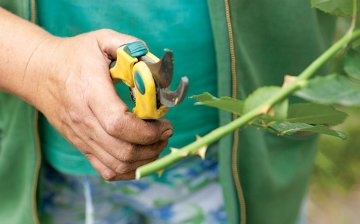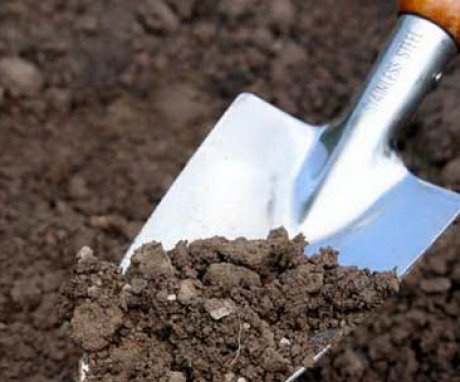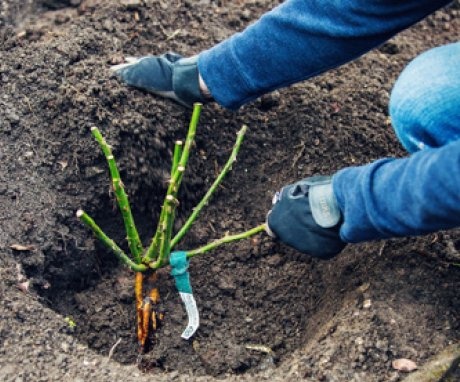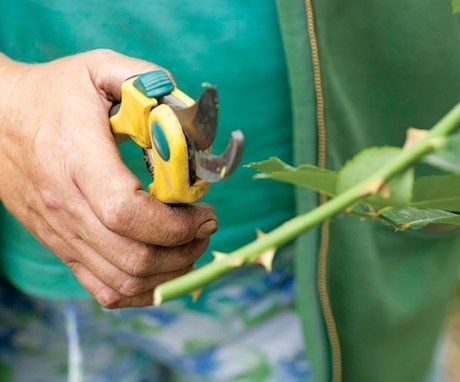Recommendations for gardeners: how to plant roses in open ground
Landing roses for most gardeners on their site it remains the ultimate dream. And all because they think they cannot cope with the care of these beautiful flowers. There is no need to be afraid, because with the right choice of the variety, planting, and care, everything will work out.
Content:
- Choosing varieties of roses
- Proper storage of seedlings
- Site preparation for landing
- Planting seedlings: in spring and autumn
- Growing from cuttings
- Growing from a bouquet
Choosing varieties of roses
Planting material is best purchased in the autumn - this is the best time for planting. Below are several varieties of roses that are distinguished by their unpretentious care:
- Rose "Iceberg" refers to polyanthous varieties... Differs in flowering from July to September of terry snow-white flowers with a strong aroma. This variety requires well-drained, fertile soils and well-lit areas. To extend the flowering period, "Iceberg" must be constantly fed fertilizers and cut off faded inflorescences in a timely manner. It is best to plant these roses in areas that are protected from the wind. For the winter period, this variety is insulated.
- The Avila Palace rose is a representative of the Floribunda variety, which is popular among summer residents and gardeners. Blooms in pink double flowers. It tolerates the effects of frost well, but is very picky about the quality of the soil. It must drain well and be fertile. It has a bad attitude towards stagnant dry air and needs protection from strong winds. Although this variety loves bright light, it is better not to allow exposure to direct sunlight. The entire summer period from the Avila Palace bush should be cut off inflorescences that have already faded, and constantly fed with fertilizers.
- "King Arthur" belongs to the variety of park and wrinkled roses. Differs in pink-orange flowers and delicate aroma. The variety blooms profusely several times per season (summer period). The place for this queen of flowers should have good lighting, without exposure to drafts. The soil must be fertile and free of stagnant water. In order for King Arthur to bloom a second time, you need to regularly prune and fertilize inflorescences that have already bloomed.
- The representative of the variety of hybrid tea roses - "Augusta Louise" repeatedly and repeatedly blooms throughout the summer. The flowers are distinguished by beautiful apricot shades and an unobtrusive fruity aroma. The variety is planted in areas that are well lit by the sun. Drafts are best avoided. "Augusta Louise" needs constant contributions fertilizers and removing inflorescences that have already faded. In winter, care must be taken to ensure that the plant is well protected from the effects of the wind.
Proper storage of seedlings
To roses wintered well and did not disappear for planting, from September to November, they should be well covered for the winter. To do this, you need to pay attention to a few tips:
- The plant, obtained in late autumn, is dropped in the basement into slightly moistened sand. The temperature in this room should not be lower than 0 degrees. Maximum, it can drop to -2 degrees. The basement itself should be slightly damp.If it is dry, the area should be sprayed regularly.
- If for some reason there is no basement, roses can just as well be stored in a trench or pit. To do this, a recess is dug in such a way that a distance of 5 to 10 cm remains between the ground and the shelter for air access. From above, the pit is covered using improvised means. If the winter is very cold, then to prepare for it, earth and sheets are piled over the trench so that the seedlings do not freeze and survive this period.
- If the seedlings are frozen during shipment, they are left in a room with a cool temperature until they thaw. A little dried up roses for landing (a distinctive feature is the wrinkled bark) is removed for a day in water. After the performed manipulations, the seedlings are added dropwise in the shade. The ground must be moist.
Site preparation for landing
If a place for cultivation roses have not been prepared, you need to do it as quickly as possible. To do this, dig depressions, no more than 50 cm. Remove to the side a twenty-centimeter layer of soil, which is at the top. To it add 25 g of superphosphate, 8 kg of mullein, 10 g of potassium dressings for each of the pits. In case of a lack of soil from the upper layers, you can add a little from the lower ones.
All added fertilizers are well mixed.
A layer of mullein with fertilizers is poured into each of the pits, and dug onto a shovel. The layer of mullein should be at least 10 cm. Next, you need to cover it with earth until you get a slide. The roots of the roses are laid out on the resulting roller, and sprinkled with the remaining soil. So that voids do not form around the roots, the earth is slightly compacted after planting, making a small hole near the bush. This is necessary so that the water does not spread during watering.
Planting seedlings: in spring and autumn
Rose seedlings can be planted both in autumn and spring. Gardeners most often use the first method. Until severe frosts come, it is necessary to ensure good root survival. If the planting is carried out correctly, then after two weeks, tiny white roots will appear on the roots of the roses. Before the first frost comes, the roses will have time to harden and take on a brown color. In other words, active growth root hairs will appear. In this state, the roses will be able to survive the winter perfectly. And in the spring, the roots and aerial parts of the seedlings will begin to develop.
There are times when roses planted in the south wake up and buds begin to grow in the autumn. This is fine. In this case, pinch the young shoot after the third leaf appears on it.
When the third leaf has not yet appeared, and the approach of frost is already approaching, young shoots are pinched so that a shoot with a length of about 1 cm remains.
Planting in spring:
-
During this period, it is recommended to plant seedlings as early as possible, because they do not take root well due to the small amount of sun, and, as a result, evaporation of moisture from the roots and poor survival.
-
Before planting, the roots and stems are cut in such a way that the number of roots corresponds to the number of shoots.
- After the shoots are removed, those that remain (their number should vary from 1 to 5) are shortened to 10 cm. In this case, no more than 3 dormant buds should remain on each shoot. This method is a guarantee that the bushes will take root well.
- Planting seedlings is carried out in a well ground. The depth of the digging should be up to 60 cm.The distance between the rows is made from 80 cm to 100 cm, and between the rose bushes from 30 cm to 60 cm.The hole for planting or the trench should be of such a size that the roots are freely placed in them.
- Water the plant abundantly. Water for each bush requires at least 10 liters (approximately one bucket). But it is not worth pouring roses either. After three days, the soil is slightly loosened (about 3 cm). The bush must be spud up to the place where the shoots are located (about 10 cm).The soil from the shoots is removed when the buds begin to develop.
Growing from cuttings
Sometimes plant roses seedlings are simply not possible. To do this, gardeners resort to another method - growing from cuttings... Cuttings are prepared in the following way - take the middle or upper part from healthy stems. Next, you need to cut the shoots into small pieces, which should have three buds.
The top of the cut is cut straight, as opposed to the bottom. It should sit directly above the kidneys and have a 45-degree angle. It is best to selectively trim the leaves. To do this, remove all existing lower leaves, and leave the upper leaves in small quantities.
Gardeners usually root such a plant in two ways - with the help of water or soil.
For the first method, a glass jar is filled with boiled water and placed in a room with dim lighting. Water needs to be added or changed periodically. After the roots form on the cuttings (after a month), they are transferred to pots filled with soil.
The second method is that a mixture of sphagnum, sand, fertile soil, and peat is placed in a pot, and planted cuttings so that they are slightly tilted. Further, each stalk should be covered with a regular glass jar, as if creating a greenhouse. Water as needed. In this case, the bank does not need to be removed. You can open it only when young shoots appear on the plant.
Growing from a bouquet
It will not be difficult to get exactly the same beautiful roses as in a bouquet:
- You need to start by properly preparing the stems. To do this, the bouquet should be placed in a container with water, which must be changed daily. At night, roses are placed in a vase of clean water to the level of the buds. Cuttings you can start when the flowers begin to get rid of their petals.
- Next, you need to take the stems and cut into cuttings. This is done in the usual way, leaving no more than one or two buds on each part. This method allows you to increase the amount of planting material, and, consequently, increase the survival rate of rose cuttings.
- The cuttings are rooted in the soil in the usual way. The roses are stuck up to the bud, so that they are upright. Subject to the correct leaving shoots will be able to take root after a month and young shoots will appear on them. If roses were planted in open ground, they are dug up by winter and placed in pots until winter passes. The pots are removed to the basement. The plant will be able to winter in the soil only in the second year. To do this, they will need to be well covered.
- To feed the bushes, growth should be done when the young shoots reach 15 cm.For this purpose, it is best to use a mullein solution. You can dissolve a special combination top dressing in water (0.5 tablespoons per bucket). Feeding the plant with nitrogen fertilizers is finished in the middle of summer, and as for potash and phosphorus fertilizers, they are applied before the beginning of the autumn period.
In order to successfully grow beautiful roses using one of the above methods, plants need to be given a large amount of light, watered moderately and regularly, spray, and keep at a temperature of at least +23 degrees. Under such conditions, the appearance of beautiful roses on the site will not keep you waiting long.
More information can be found in the video.





